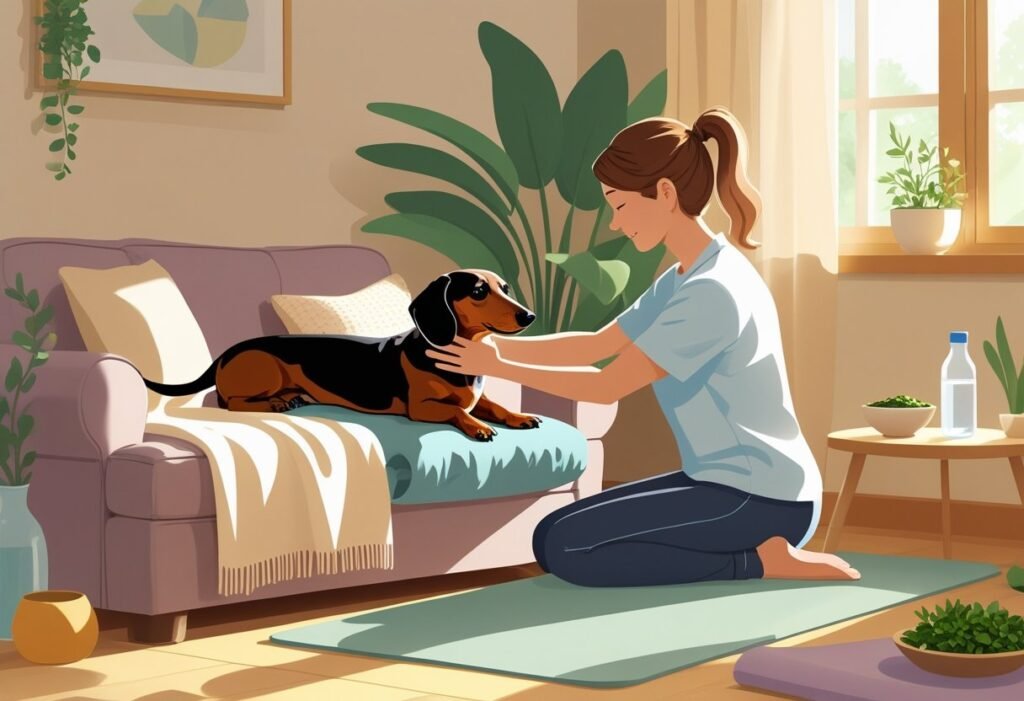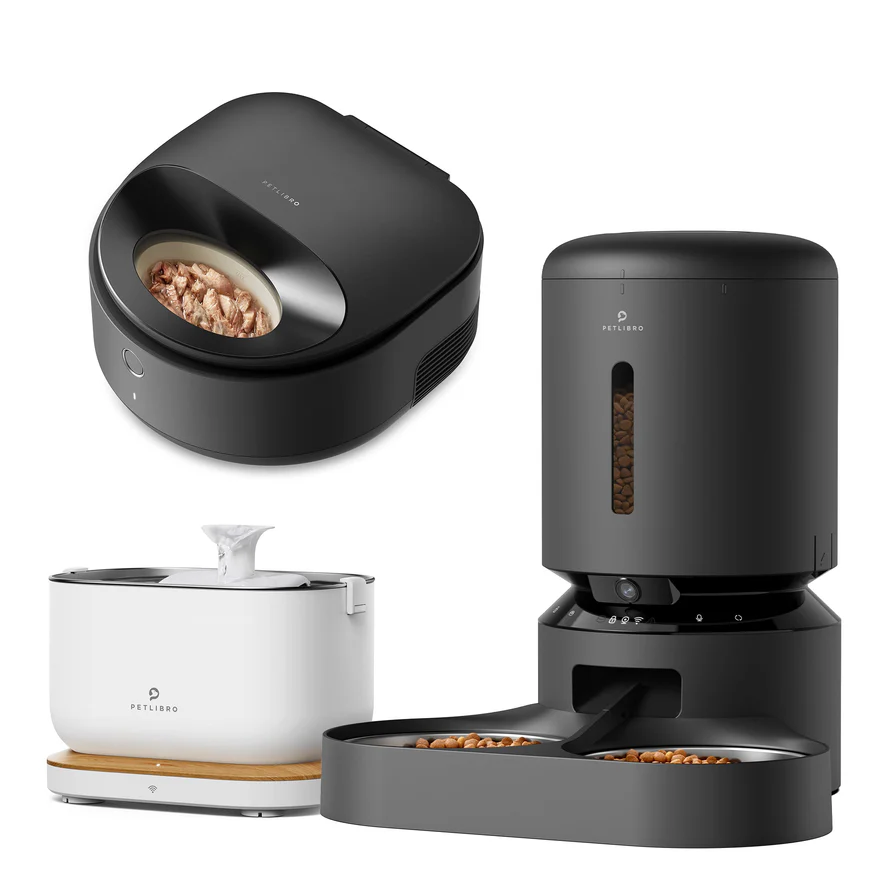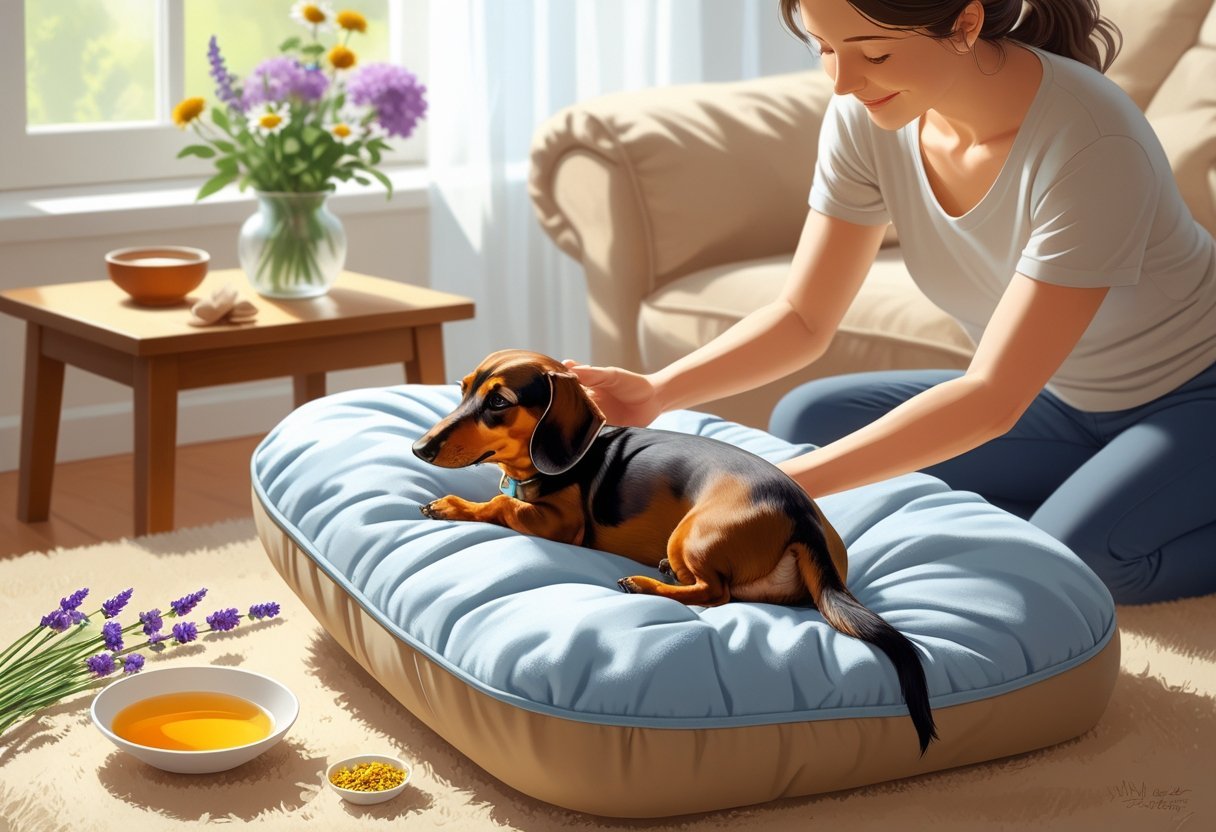If your dachshund seems uncomfortable or in pain, you want to help right away. There are some simple home remedies and comfort tips you can try to bring relief and make life a bit easier for them. 🐶
These steps can help with mild pain and may support your dog’s well-being. It’s not always a quick fix, but a little extra care makes a difference. Some gentle massages can be included as part of home remedies for dachshund pain relief. 💆♂️
You’ll learn how to spot signs your dachshund might be hurting, ways to ease their discomfort, and when it’s time to call your vet. These tips cover changes at home, diet tweaks, and little shifts in daily life so your pet feels better day by day. 🏡
Key Takeaways ✅
- Learn how to spot pain in dachshunds and respond early. 🔍
- Discover safe home remedies and comfort strategies. 🌿
- Know when to seek extra help from a veterinarian. 👩⚕️
🐾 Free Dachshund Care Guide
Download our free checklist to ensure your Dachshund stays happy, healthy, and well-loved!
Get Your Free Guide 🐶Recognizing Pain in Dachshunds

Pain in dachshunds isn’t always obvious. You’ll need to notice changes in how they act, move, or look to catch it early. 🧐
Common Signs of Chronic Pain 💢
Some signs of chronic pain in dachshunds are pretty subtle. Maybe your dog limps, moves slowly, or struggles to get up or lay down. 🐾
Sometimes they avoid stairs or don’t jump as much as usual. They might pant more or seem restless, and you might catch them licking or chewing at certain spots. 😟
Chronic pain can cause whining or yelping when touched, especially along their back or legs. Appetite or sleeping habits might change too—dogs in pain often eat less and sleep more. 🍽️
Watch for any new behaviors that stick around for more than a few days. It’s not always dramatic, but little things add up. 📆

🌿 Wild Earth Dog Food – Gentle Nutrition for Healing
Specially formulated with clean, plant-based ingredients, this vet-developed food supports reduced inflammation and joint pressure—ideal for Dachshunds recovering from back pain or chronic discomfort.
- ✅ High protein, hypoallergenic, and easy to digest
- ✅ No fillers, animal by-products, or artificial junk
- ✅ Helps maintain a healthy weight and energy balance
Behavioral Changes to Watch For 🧠
Behavioral changes can be the first hint your dachshund is hurting. A friendly dog might get withdrawn or cranky. 😕
Sometimes they don’t want to be petted or picked up. You might notice your dog avoids playtime or stops greeting you at the door. 🎾

If your dog starts hiding or spending more time alone, pay attention. Unusual barking, growling, or snapping can also happen. 🐶
Notice if your dog seems anxious or less social with people and pets. These changes can point to long-term pain, even if you don’t see an obvious injury. 💬
Physical Symptoms in Dachshunds 🐕
Pain can show up in your dachshund’s body language and appearance. Look for a stiff walk, arched back, or limping. 🦴
They may keep their tail low or pin their ears back. Check for swelling, heat, or sensitivity in their legs, back, or paws. 🔥
Sometimes muscles look tight, or they resist having their feet or back touched. You might see more panting, shaking, or drooling. 😓
Dachshunds in chronic pain often struggle to get comfortable or shift positions a lot when resting. Keep an eye out for these signs if you suspect your dog’s in pain. 🛏️
Home Remedies for Dachshund Pain Relief

Some simple home remedies can help reduce your dachshund’s pain. You can make your pet more comfortable with gentle warmth, supportive handling, supplements, and by making small changes to your daily routines. 🐾
Warm Compresses and Comforting Techniques 🌡️
Try a warm compress to relieve muscle aches and joint pain. Use a clean towel soaked in warm water or a microwavable heating pad, but always check it’s not too hot. 🔥
Place the compress on sore spots for about 10 minutes. This can help with stiffness and improve blood flow. 💧
Set up your dog’s bed in a quiet area away from drafts, and make sure the bedding is soft and supportive. A cozy, calm space really matters during recovery. 🛏️
Gentle petting can also reassure your pet. Skip rough play or sudden moves for now. 🤗

🩺 The Swiftest Pet Insurance — Peace of Mind for Pain Management
Chronic pain, joint stiffness, or injuries can require ongoing care. The Swiftest Pet Insurance ensures your Dachshund gets timely treatments, therapies, and medications — without worrying about high vet costs.
- ✅ Covers pain management treatments and vet visits
- ✅ Helps with chronic conditions like arthritis or IVDD
- ✅ Quick, transparent claims for stress-free recovery
Massage and Gentle Physical Therapy 💆♀️
Massage can relax tense muscles and soothe mild pain. Use your fingers to apply light pressure along your dachshund’s back, legs, and neck. 🐶
Move slowly and watch for any discomfort. Physical therapy at home might mean gentle stretching or short, slow walks on flat ground. 🚶♀️
Stop if your dog yelps or starts limping. Routine massage and gentle movement can keep muscles supple, but overdoing it can backfire. ⚠️
Never force movement or use heavy pressure. If you’re unsure how to massage your dachshund, ask your vet to show you. 🩺

🎉 Grab your free Dachshund care checklist!
Safe Herbal and Natural Supplements 🌿
Some natural supplements might provide mild relief for minor pain. Glucosamine and chondroitin are popular for joint health. 💊
Omega-3 fatty acids from fish oil can help with inflammation. Turmeric (curcumin) is another option. 🌼
Common safe supplements:
Glucosamine (for cartilage support) 🦴
Fish oil (anti-inflammatory) 🐟
Turmeric (contains curcumin, a natural anti-inflammatory) ✨
Check with your vet before starting any supplement—some herbs and oils can be harmful to dogs. Don’t use products made for people. 🚫
Optimizing Rest and Activity Levels ⚖️
Rest is important for healing, but too much inactivity can lead to muscle loss. Set up a safe space where your dachshund can rest without needing to jump or climb stairs. 🪜
Keep walks short and slow, sticking to soft, even ground. Avoid running, fetch, or letting your dog jump on and off furniture. 🚫
Use ramps if you need to protect their joints. Adjust daily routines to balance rest and gentle activity. 🧘♂️
Watch for signs your dog needs more downtime or is ready for a little more movement. It’s a balancing act, honestly. 🌀
Diet and Nutrition for Pain Management

Feeding your dachshund the right foods and managing their weight can help lower pain from joint or back problems. Sometimes, simple diet changes make a real difference. 🥗
Anti-Inflammatory Foods for Dachshunds 🌿
Some foods naturally help reduce swelling in joints and tissues. Adding these to your dachshund’s meals might ease pain from arthritis or injury. 🐶
Options to consider:
- Salmon: Packed with omega-3s, salmon helps fight inflammation. 🧊
- Blueberries: High in antioxidants, these fruits protect cells and help lower inflammation. 🫐
- Sweet potatoes: They offer fiber and vitamins and are easy on the stomach. 🍠
- Turmeric: Contains curcumin, which can decrease swelling. Just sprinkle a tiny bit over food, but check with your vet for the right amount. ✨
Avoid processed foods—they usually have preservatives and fillers that can make inflammation worse. Always introduce new foods slowly and watch for any signs of stomach upset or allergies. ⚠️

🛏️ Majestic Orthopedic Bed
- ✅ Eases pressure on joints and spine while resting
- ✅ Memory foam base supports healing and comfort
- ✅ Ideal for dogs with IVDD, arthritis, or chronic pain

🪜 Majestic Pet Stairs
- ✅ Helps prevent jumping that worsens back pain
- ✅ Soft surface with sturdy support for small legs
- ✅ Perfect for getting on and off beds or couches safely

Weight Management for Reduced Joint Stress ⚖️
Extra weight puts more pressure on your dachshund’s back and joints, making pain worse. Keeping your dog at a healthy weight can ease this stress and help them move better. 🐾
Tips for managing weight:
- Measure food portions accurately. 📏
- Offer low-calorie treats, like small apple pieces or carrots. 🥕
Table: Healthy Weight Ranges for Dachshunds
| Type | Ideal Weight |
|---|---|
| Miniature | 8–11 pounds |
| Standard | 16–32 pounds |
Feed your dachshund scheduled meals instead of leaving food out all day. Regularly check their shape by feeling for ribs—there shouldn’t be too much fat over them. 🤲
Talk with your vet about the best diet plan for your dog’s needs. Sometimes it takes a few tweaks to get it right. 🩺
Creating a Comfortable Environment

Dachshunds with pain need special attention at home. Focus on their bedding and daily movement to help reduce discomfort and protect their joints and back. 🛋️
Supportive Bedding and Soft Surfaces 🛏️
Pick a bed with orthopedic or memory foam to support your dachshund’s back and joints. Thin or lumpy beds just don’t cut it and can make pain worse. 🧼
Put the bed in a quiet spot, away from drafts and direct sunlight. Make sure your dog can get in and out easily without jumping or stretching. 🌤️
Add soft mats or rugs around the house, especially on hard floors. These help prevent slips and make it easier for your dachshund to move around. 🐾
Quick Tips:
- Wash bedding often to keep it clean. 🧺
- Use low, padded beds for easier access. 🛏️
- Avoid high beds or couches that require jumping. 🚫

🧫 AnimalBiome Gut Health Test Kit
- ✅ Identifies gut imbalances linked to inflammation and pain
- ✅ Personalized microbiome report for targeted relief
- ✅ Supports natural recovery and immune balance

🌿 Innovet PurCBD Oil
- ✅ Natural pain relief for joints, muscles, and inflammation
- ✅ Promotes relaxation and stress reduction during recovery
- ✅ Organic, lab-tested formula safe for daily use
Adjusting Home Layout for Easy Movement 🏡
Move furniture to create clear paths for your dog. Remove clutter or objects that could cause trips, especially in busy areas like the kitchen or hallway. 🪑
Place ramps or pet stairs next to couches or beds if your dachshund needs to get up or down. Blocks or steps should be sturdy and have a non-slip surface. 🪜
Cover slippery floors with rugs or carpets in main walkways. If your home has stairs, install gates to keep your dachshund from climbing or falling. 🚧
Suggestions:
- Keep food and water bowls at ground level. 🍽️
- Use baby gates to block unsafe areas. 🚼
- Check paths daily for obstacles or spills. 🧹
Lifestyle Changes to Support Long-Term Relief

Small changes at home can really help manage pain and make your dachshund more comfortable. Focus on routines and the environment to protect your pup’s back and joints. 🏡
Safe Exercise Routines 🐕
Gentle, controlled exercise keeps dachshunds healthy without overdoing it. Try sticking to slow walks on flat ground—nothing wild, just steady movement. 🚶♂️
Avoid running, jumping, or sharp turns. These can put extra strain on your dog’s spine and really aren’t worth the risk. ⚠️
Two or three short walks a day work well for most dachshunds. Each walk might be 10–20 minutes, but let your dog decide the pace. ⏱️
If your dachshund likes water, supervised swimming is a solid, low-impact option. Not every pup is a swimmer, though, so see how they feel about it. 💧
Always pick a harness over a collar. It puts less pressure on their neck and back, which is just better overall. 🦴
Use ramps or steps for getting onto furniture or into cars. You want to avoid any jumping if possible. 🪜

🍲 ChefPaw Fresh Food Maker
- ✅ Make nutritious, gentle meals at home—fresh and preservative-free
- ✅ Ideal for Dachshunds with pain-related food sensitivities
- ✅ Take control of every ingredient for peace of mind

⏱️ Petlibro Smart Auto Feeder
- ✅ Keeps feeding times consistent for a balanced routine
- ✅ Great for Dachshunds on pain meds or special diets
- ✅ Helps reduce stress and begging between meals

Sample Weekly Exercise Plan:
| Day | Activity | Time |
|---|---|---|
| Monday | Gentle Walk | 15 min (x2) |
| Tuesday | Supervised Swim | 10 min |
| Wednesday | Gentle Walk | 15 min (x2) |
| Thursday | Play (indoors) | 10 min |
| Friday | Gentle Walk | 15 min (x2) |
Minimizing Triggers and Hazards 🧹
Look around your house for potential hazards. Stairs are a big one—block them off with baby gates so your dachshund can’t sneak up or down. 🚼
Put non-slip mats on tile or hardwood floors. Dachshunds don’t have the best traction, and slipping can really mess up their backs. 🧻
Keep food and water bowls at a height that doesn’t force your dog to stretch or crouch. That little bit of effort matters over time. 🍽️
Pick up clutter, toys, and anything else your dog could trip over. You want clear walkways so there’s no chance of a weird twist or stumble. 🧸
Arrange your furniture so your dachshund doesn’t have to jump to reach favorite resting spots. It’s a simple thing but makes a difference. 🛋️
Check your dachshund’s bedding. Go for a firm, supportive dog bed—soft and thick is even better for sore joints and muscles. 🛏️
If you can, keep things quiet and calm at home. Stress just makes pain worse, honestly. 😌
When to Seek Veterinary Assistance

Sometimes home remedies just don’t cut it. You need to know when symptoms are out of your hands and it’s time to call the vet. 📞
Warning Signs That Warrant Immediate Attention 🚨
Some symptoms mean you shouldn’t wait. Get your dachshund to a veterinarian right away if you see:
- Sudden yelping or crying 🐾
- Paralysis or limb weakness 🦴
- Loss of bladder or bowel control 🚫
- Dragging back legs 🐕
- Severe swelling or obvious injury 💥
- Breathing difficulties 😮💨
- Loss of appetite for more than 24 hours 🍽️
If your dog seems restless, trembles, or can’t get comfortable after trying basic pain relief, that’s a red flag. Don’t hesitate—emergency care is the safest route if you notice any signs of spinal injury or your pet’s in real distress. 🚑
🌿 Smart Comfort & Care Essentials for Pain-Free Doxies 🐾
- 💧 Petlibro Water Fountain — Encourage steady hydration to support joint flexibility and recovery from inflammation or pain.
- 📹 Petcube Cam 360 — Monitor your Dachshund’s movements or rest periods after injuries, ensuring they’re healing comfortably while you’re away.
- 📍 Tractive DOG GPS Tracker — Track gentle walks and monitor safe exercise routines without overexerting your Doxie during recovery.
- 🍪 Petcube Bites 2 — Reward calm behavior or gentle stretches during recovery sessions, and monitor your Doxie’s comfort remotely.
Integrating Home Remedies with Professional Care 🩺
Gentle massage, soft bedding, and heat packs can help with mild pain. Over-the-counter supplements like fish oil or glucosamine might support joint health, but don’t give your dachshund human meds like ibuprofen or acetaminophen—seriously, just don’t. ⚠️
Your vet can recommend safe pain relief, whether that’s prescription medication, physical therapy, or even surgery in some cases. Regular checkups help your vet track your dog’s progress and tweak treatments as needed. 🗓️
Let your vet know what you’ve already tried at home. That info helps them come up with the best plan for your dachshund. 📋
Summary of Dachshund Pain Relief Options
If your dachshund’s in pain, you’ve got a few safe things to try at home before heading to the vet. 🐾
Rest and Limiting Movement
Keep your dog calm and comfy. Limit running, jumping, and stairs. Using a crate or small room can help keep your dachshund safe. 🛑
Simple Home Remedies
Try a soft, warm blanket or a heating pad on low for sore muscles. Make sure your dog’s water and food are easy to reach. 🛏️
Over-the-Counter Aids
Never give human pain medicine without your vet’s advice. Some pet supplements with glucosamine and chondroitin might help, but check first. ⚠️
Diet and Weight Control
Feed your dachshund a balanced diet. Extra weight just puts more stress on their joints and back. ⚖️
Grooming and Massage
Gentle massage can loosen up stiff spots. Brush your dog carefully—don’t make things worse. 💆♂️
💛 Comfort & Calm Essentials for Dachshund Pain Relief 🐾
- 🎽 Embark Pet Adventure Harness – Reduce neck and back strain with an ergonomic, no-pull harness that supports pain-free walks and proper posture.
- 🛁 Pride + Groom Grooming Tools Kit – Gentle, easy-to-use tools that keep your Doxie’s coat clean and healthy, preventing irritation that can worsen pain or discomfort.
- 🌿 Zumalka Calmpet Anxiety Relief Drops – Natural, homeopathic support that eases pain-related anxiety and promotes calm recovery after vet visits or injuries.
- 🎨 Purr & Mutt Personalized Dachshund Art – Celebrate your Doxie’s bravery and healing journey with a custom art piece that radiates love and comfort.
- 👕 Dog is Good Apparel & Gifts – Spread positivity while supporting your Doxie’s healing time with cozy, uplifting apparel designed for dog lovers.
🐶 Gentle care, soothing calm, and a little love go a long way — help your Dachshund recover comfortably and stay happy every day.
Common Pain Relief Options 🩺
| Option | At Home | With Vet’s Help |
|---|---|---|
| Rest | ✓ | ✓ |
| Heat Pad | ✓ | |
| Prescription Meds | ✓ | |
| Joint Supplements | ✓ (with vet OK) | ✓ |
| Gentle Massage | ✓ |
If pain sticks around or seems severe, call your vet as soon as you can. 📞
🐾 Don’t Miss Out!
Download our free Dachshund care guide to keep your furry friend happy and healthy.
Get Your Free Guide 🐶Frequently Asked Questions

With gentle home care and safe items you already have, you can help ease your dachshund’s pain. These tips work for back pain, muscle soreness, joint pain, and mild discomfort. 🐶
How can I alleviate my Dachshund’s back pain using home methods? 🛏️
Encourage your dog to rest and avoid jumping on furniture or climbing stairs. Use a soft, supportive bed to protect their back. 🐾
Try a warm compress (not hot) on the sore area for short periods, and always check your dog’s skin. Sometimes, gentle belly rubs help your dog relax. 💆♀️
What natural remedies can soothe my dog’s muscle pain effectively? 🌿
Massage your dachshund’s sore muscles with gentle, circular motions. A heating pad on the lowest setting, wrapped in a towel, can offer some soothing warmth. ♨️
Omega-3 supplements from fish oil might help with mild inflammation—but always ask your vet first. 🩺
Are there any home remedies for managing chronic pain in dogs with cancer? 🕯️
Keep your dog’s living area quiet and cozy. Orthopedic beds and gentle massage may offer some comfort. 🛋️
Offer soft, easy-to-eat foods if your dog’s appetite isn’t great. Always check with your vet before trying supplements or herbs, since some can mess with treatments. 🍲
Which over-the-counter medications are safe for dog pain relief? ⚠️
Don’t give your dog human pain relievers like ibuprofen, acetaminophen, or aspirin—they’re dangerous. Only use meds your vet has approved for your dog. ❌
Some pet stores sell pain relief chews for dogs, but always talk to your vet before starting anything new. 🐕
What household items can I use for canine joint pain relief? 🦴
Non-slip mats or rugs help your dog move around safely and reduce joint strain. Steps or ramps make it easier for your dachshund to get on or off furniture without jumping. 🪜
Elevate your dog’s bowls to a comfortable height if they’re stiff. Warm, moist towels can bring mild relief to aching joints. 💧
How do I provide natural pain relief for my dog’s acute discomfort? 😌
Let your dog have plenty of quiet time to rest. 🛑
Try using cold packs or a damp washcloth for short periods on any swollen or sore spots. Just don’t freeze the area—gentle is best. 🧊
Make sure your dog stays hydrated. Leave favorite toys or snacks nearby; sometimes a little distraction helps more than you’d think. 🧸
If your dog’s discomfort sticks around or seems to get worse, it’s time to call your vet. 📞



